The NVIDIA GeForce GTX 980 Ti Review
by Ryan Smith on May 31, 2015 6:00 PM ESTCompute
Shifting gears, we have our look at compute performance. Since GTX Titan X has no compute feature advantage - no fast double precision support like what's found in the Kepler generation Titans - the performance difference between the GTX Titan X and GTX 980 Ti should be very straightforward.
Starting us off for our look at compute is LuxMark3.0, the latest version of the official benchmark of LuxRender 2.0. LuxRender’s GPU-accelerated rendering mode is an OpenCL based ray tracer that forms a part of the larger LuxRender suite. Ray tracing has become a stronghold for GPUs in recent years as ray tracing maps well to GPU pipelines, allowing artists to render scenes much more quickly than with CPUs alone.
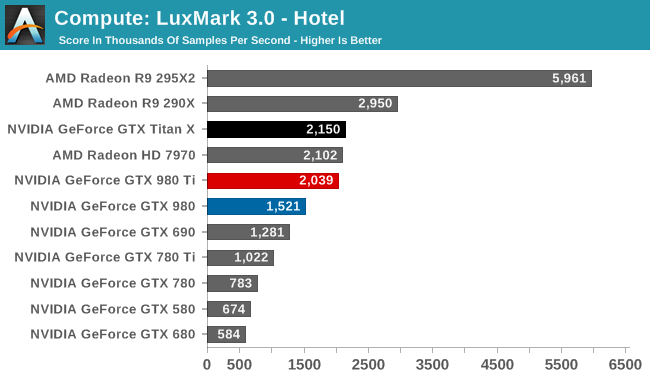
With the pace set for GM200 by GTX Titan X, there’s little to say here that hasn’t already been said. Maxwell does not fare well in LuxMark, and while GTX 980 Ti continues to stick very close to GTX Titan X, it none the less ends up right behind the Radeon HD 7970 in this benchmark.
For our second set of compute benchmarks we have CompuBench 1.5, the successor to CLBenchmark. CompuBench offers a wide array of different practical compute workloads, and we’ve decided to focus on face detection, optical flow modeling, and particle simulations.
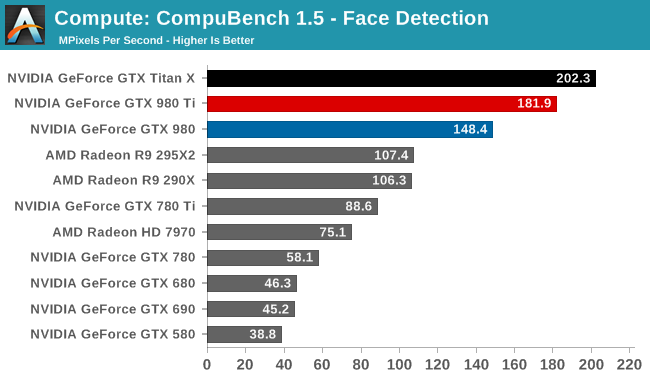
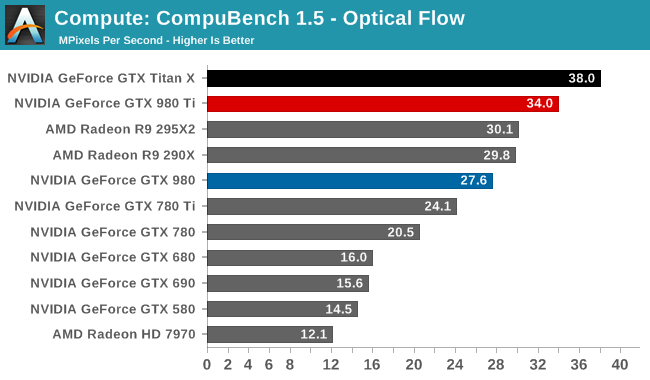
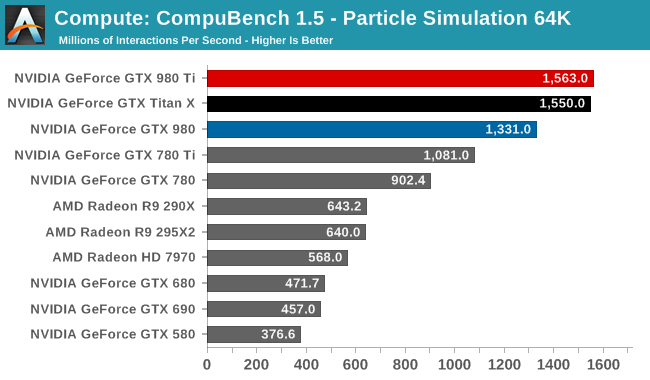
Although GTX T980 Ti struggled at LuxMark, the same cannot be said for CompuBench. Though taking the second spot in all 3 sub-tests - right behind GTX Titan X - there's a bit wider of a gap than normal between the two GM200 cards, causing GTX 980 Ti to trail a little more significantly than in other tests. Given the short nature of these tests, GTX 980 Ti doesn't get to enjoy its usual clockspeed advantage, making this one of the only benchmarks where the theoretical 9% performance difference between the cards becomes a reality.
Our 3rd compute benchmark is Sony Vegas Pro 13, an OpenGL and OpenCL video editing and authoring package. Vegas can use GPUs in a few different ways, the primary uses being to accelerate the video effects and compositing process itself, and in the video encoding step. With video encoding being increasingly offloaded to dedicated DSPs these days we’re focusing on the editing and compositing process, rendering to a low CPU overhead format (XDCAM EX). This specific test comes from Sony, and measures how long it takes to render a video.

Traditionally a benchmark that favors AMD, GTX 980 Ti fares as well as GTX Titan X, closing the gap some. But it's still not enough to surpass Radeon HD 7970, let alone Radeon R9 290X.
Moving on, our 4th compute benchmark is FAHBench, the official Folding @ Home benchmark. Folding @ Home is the popular Stanford-backed research and distributed computing initiative that has work distributed to millions of volunteer computers over the internet, each of which is responsible for a tiny slice of a protein folding simulation. FAHBench can test both single precision and double precision floating point performance, with single precision being the most useful metric for most consumer cards due to their low double precision performance. Each precision has two modes, explicit and implicit, the difference being whether water atoms are included in the simulation, which adds quite a bit of work and overhead. This is another OpenCL test, utilizing the OpenCL path for FAHCore 17.
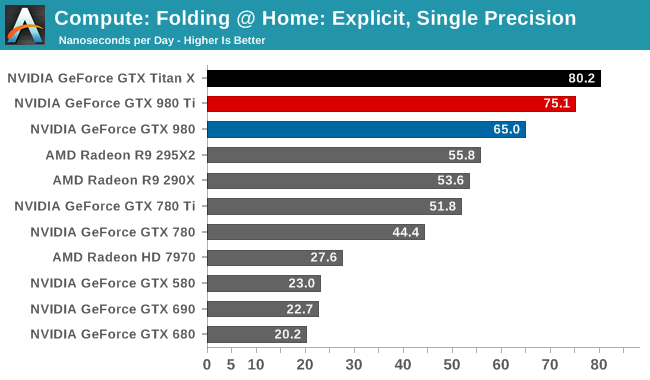
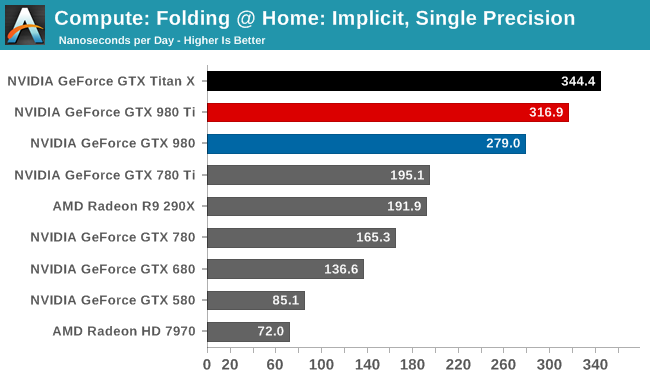
Folding @ Home’s single precision tests reiterate GM200's FP32 compute credentials. Second only to GTX Titan X, GTX 980 Ti fares very well here.
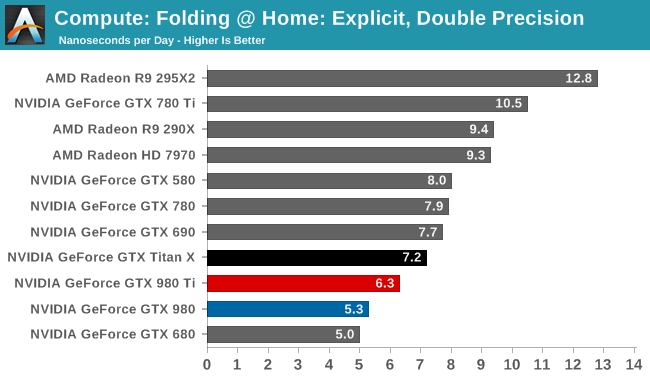
Meanwhile Folding @ Home’s double precision test reiterates GM200's poor FP64 compute performance. At 6.3ns/day, it, like the GTX Titan X, occupies the lower portion of our benchmark charts, below AMD's cards and NVIDIA's high-performnace FP64 cards.
Wrapping things up, our final compute benchmark is an in-house project developed by our very own Dr. Ian Cutress. SystemCompute is our first C++ AMP benchmark, utilizing Microsoft’s simple C++ extensions to allow the easy use of GPU computing in C++ programs. SystemCompute in turn is a collection of benchmarks for several different fundamental compute algorithms, with the final score represented in points. DirectCompute is the compute backend for C++ AMP on Windows, so this forms our other DirectCompute test.

We end up ending our benchmarks where we started: with the GTX 980 Ti slightly trailing the GTX Titan X, and with the two GM200 cards taking the top two spots overall. So as with GTX Titan X, GTX 980 Ti is a force to be reckoned with for FP32 compute, which for a pure consumer card should be a good match for consumer compute workloads.










290 Comments
View All Comments
Yojimbo - Monday, June 1, 2015 - link
After some research, I posted a long and detailed reply to such a statement before, I believe it was in these forums. Basically, the offending NVIDIA rebrands fell into three categories: One category was that NVIDIA introduced a new architecture and DIDN'T change the name from the previous one, then later, 6 months if I remember, when issuing more cards on the new architecture, decided to change to a new brand (a higher numbered series). That happened once, that I found. The second category is where NVIDIA let a previously released GPU cascade down to a lower segment of a newly updated lineup. So the high end of one generation becomes the middle of the next generation, and in the process gets a new name to be uniform with the entire lineup. The third category is where NVIDIA is targeting low-end OEM segments where they are probably fulfilling specific requests from the OEMs. This is probably the GF108 which you say has "plagued the low end for too long now", as if you are the arbiter of OEM's product offerings and what sort of GPU their customers need or want. I'm sorry I don't want to go looking for specific citations of all the various rebrands, because I did it before in a previous message in another thread.The rumors of the upcoming retail 300 series rebrand (and the already released OEM 300 series rebrand) is a completely different beast. It is an across-the-board rebrand where the newly-named cards seem to take up the exact same segment as the "old" cards they replace. Of course in the competitive landscape, that place has naturally shifted downward over the last two years, as NVIDIA has introduced a new line up of cards. But all AMD seems to be doing is introducing 1 or 2 new cards in the ultra-enthusiast segment, still based on their ~2 year old architecture, and renaming the entire line up. If they had done that 6 months after the lineup was originally released, it would look like indecision. But being that it's being done almost 2 years since the original cards came out, it looks like a desperate attempt at staying relevant.
Oxford Guy - Monday, June 1, 2015 - link
Nice spin. The bottom line is that both companies are guilty of deceptive naming practices, and that includes OEM nonsense.Yojimbo - Monday, June 1, 2015 - link
In for a penny, in for a pound, eh? I too could say "nice spin" in turn. But I prefer to weigh facts.Oxford Guy - Monday, June 1, 2015 - link
"I too could say 'nice spin' in turn. But I prefer to weigh facts."Like the fact that both companies are guilty of deceptive naming practices or the fact that your post was a lot of spin?
FlushedBubblyJock - Wednesday, June 10, 2015 - link
AMD is guilty of going on a massive PR offensive, bending the weak minds of it's fanboys and swearing they would never rebrand as it is an unethical business practice.Then they launched their now completely laughable Gamer's Manifesto, which is one big fat lie.
They broke ever rule they ever laid out for their corpo pig PR halo, and as we can see, their fanboys to this very day cannot face reality.
AMD is dirtier than black box radiation
chizow - Monday, June 1, 2015 - link
Nice spin, no one is saying either company has clean hands here, but the level to which AMD has rebranded GCN is certainly, unprecedented.Oxford Guy - Monday, June 1, 2015 - link
Hear that sound? It's Orwell applauding.Klimax - Tuesday, June 2, 2015 - link
I see only rhetoric. But facts and counter points are missing. Fail...Yojimbo - Tuesday, June 2, 2015 - link
Because I already posted them in another thread and I believe they were in reply to the same guy.Yojimbo - Tuesday, June 2, 2015 - link
Orwell said that severity doesn't matter, everything is binary?